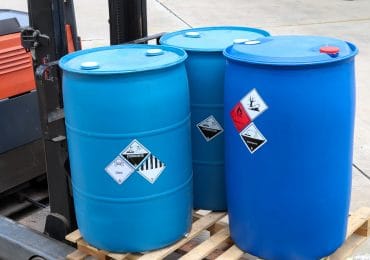
Transporting hazardous chemicals on a regular basis is crucial for companies with an industrial focus. It must be carried out in accordance with rules and regulations to ensure everything complies with safety and health standards.
Failure to do so can harm people, the environment, and other living organisms. For example, a leaking tanker of liquefied petroleum gas (LPG) may explode at any time, which could cause severe to fatal injuries to anyone within the area.
Read below to understand how these materials can be appropriately handled and transported.
What Are Hazardous Chemicals?
Hazardous chemicals are also called hazardous materials or HAZMAT. These substances are flammable, radioactive, poisonous, or explosive.
If not handled properly, they can cause harm to people and the environment. This is why proper handling of these substances is a must.
What Substances Are Classified As Hazardous Chemicals?
According to the United Nations (UN), hazardous chemicals are divided into nine classifications based on the level of risk they carry. These include explosives, gases, flammable liquids, flammable solids, and more.
- Class 1: Explosives – These are chemicals with a high possibility of creating explosions. Examples include benzoyl peroxide (dry), picric acid, peroxide-forming compounds, di and tri-nitro compounds, etc.
- Class 2: Gases – Gases include any gas that has been compressed for transportation. Examples of gases include aerosols, natural gas canisters, LPG, ammonia, ethylene, propylene, vinyl chloride, and more.
- Class 3: Flammable Liquids – These are liquids that can create combustion when they make contact with a flame. Flammable liquids include acetone (for nail polish), varnish, perfume, gasoline, adhesives, and paint.
- Class 4: Flammable Solids – Like flammable liquids, flammable solids can create combustion in the presence of a flame. Some examples include magnesium, sulfur, matches, sodium batteries, etc.
- Class 5: Organic Peroxides And Oxidizers – Organic peroxides are compounds that produce a flammable vapor, while oxidizers are substances that combust in the presence of oxygen. Examples include potassium permanganate and hydrogen peroxide.
- Class 6: Poisonous, Toxic, And Infectious Substances – These substances can cause severe and fatal injury when inhaled or ingested. Examples include methyl bromide, biological products, tear gas, forensic materials, etc.
- Class 7: Radioactive Substances – These materials release radiation at a higher concentration (>0.002 microcuries per gram). Some examples of radioactive materials include medical isotopes, enriched uranium, and X-ray machines.
- Class 8: Corrosive Substances – These goods can damage human skin and other materials at a faster rate. Examples may include sulfuric acid, glycolic acid, bromine, sodium hydroxide, paint stripper, drain cleaner, and battery fluid.
- Class 9: Miscellaneous Materials – These include all chemicals that don’t fit the above classifications. Some examples are lithium batteries, first-aid kits, dry ice, calcium hydroxide, ammonium hydroxide, and more.
Check which among these nine classifications the chemicals you want to transport belong to.
Tips For Transporting Hazardous Chemicals
Here are some tips to keep in mind when transporting hazardous chemicals to ensure safety:
- Determine The Packaging You Need
Depending on your product’s classification, you might need a UN bag, a metal drum, or an intermediate bulk container (IBC) to store and transport it. These UN-certified containers are ideal for handling both solid and liquid substances, such as those in classes 4, 5, 6, 8, and 9.
Moreover, the United Nations sets three packaging groups every chemical handler must follow. These are the following:
- Packaging Group I: This is for high-risk substances. It has a UN symbol, ‘x.’
- Packaging Group II: This is for medium-risk substances. It has a UN symbol, ‘y.’
- Packaging Group III: This is for low-risk substances. It has a UN symbol, ‘z.’
Furthermore, be careful when combining multiple classifications in one packaging. This can cause reactions that can result in explosions and other disasters.
- Get A Shipping Certification
DoT requires every company engaged in hazardous chemical transportation to undergo specific training to classify, package, and label dangerous materials for shipping. Failure to comply with this requirement can make you liable for fines and penalties.
By undergoing specific training, your employees will learn how to:
- Comply with governing rules and regulations
- Prepare the documents required to transport hazardous chemicals
- Solve common problems related to hazardous material transportation
- Classify hazardous chemicals
Obtaining a shipping certification tends to be a lengthy process. If you don’t have time to undergo specific training programs, consider partnering up with a third-party logistics (3PL) company specializing in handling and transporting hazardous materials.
- Label Your Package Correctly
Containers containing hazardous chemicals must be labeled in a specific manner. It must include the following information:
- A diamond-shaped warning placard
- A UN code
- Specific gravity
- Year of manufacture
- Country of authorization
- Manufacturer identification
- Other hazard warnings (e.g., keep away from heat, inhalation hazard, package orientation, fumigant marking, etc.)
Also, it must be big enough to be readily seen and acknowledged. You may check the U.S. Department of Transportation (DoT) Chart 16 for hazardous materials marking, labeling, and placarding for more information.
- Conduct Risk Assessments
Risk assessments ensure that you’re moving hazardous materials in the safest way possible. A certified professional will be able to carry out this step.
Risk assessors ensure that:
- The containers used are UN-certified and approved.
- The containers handling the dangerous materials aren’t damaged nor show any signs of damage, such as dents and cracks.
- The containers holding hazardous chemicals are labeled according to the rules set by the UN.
- HAZMAT employees (a specific team who handles high-risk goods) wear personal protective equipment when working with dangerous chemicals.
- HAZMAT employees are qualified to complete the process.
- The chemicals will be shipped safely and legally. They check if the substances to be transported can be shipped by road, plane, or sea because some aren’t permitted to go by plane or sea (e.g., high-risk materials).
- Backup or emergency procedures are set up in case a disaster occurs.
The goal of risk assessment is to highlight the potentially risky areas and have them addressed or reduced before the transportation process takes place. When an accident occurs, the risk assessor will outline the emergency procedures that have to be executed to minimize the damage.

Final Thoughts
Transporting hazardous chemicals or HAZMAT is a complicated task to accomplish. There are plenty of rules and regulations you need to know before you can proceed. Ignoring these can lead to hefty fines, especially when an issue—or worse, a disaster—occurs.
Take note of the different classifications of hazardous materials and follow the tips above to transport your dangerous goods in a safe and legal way.